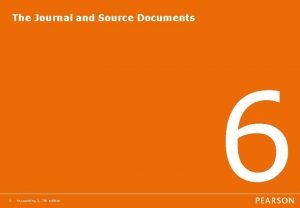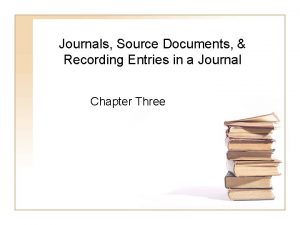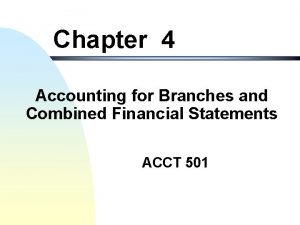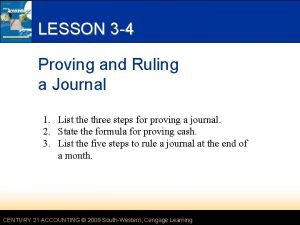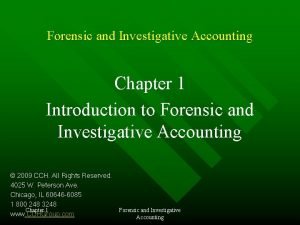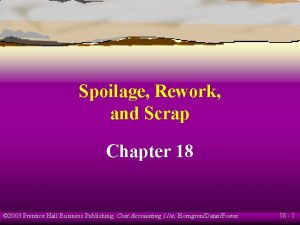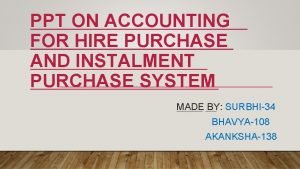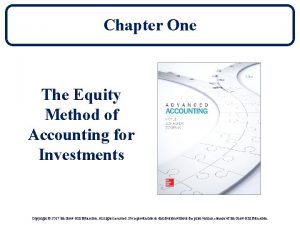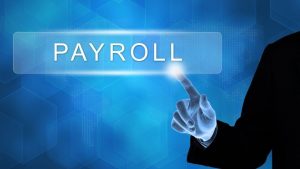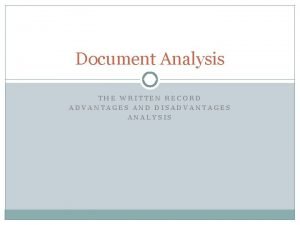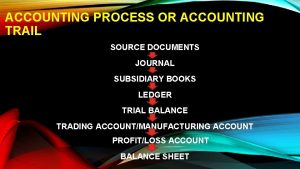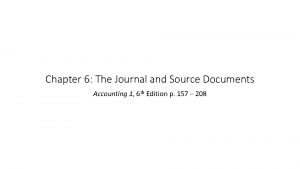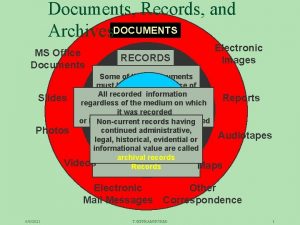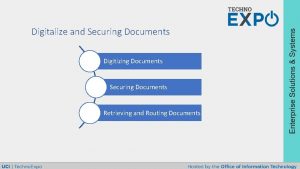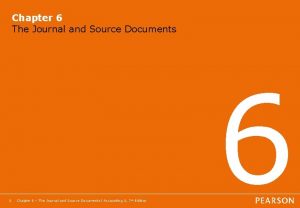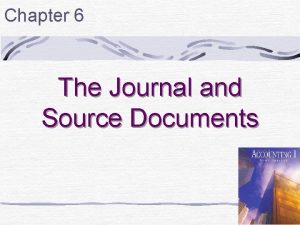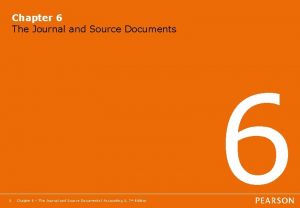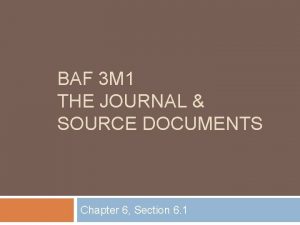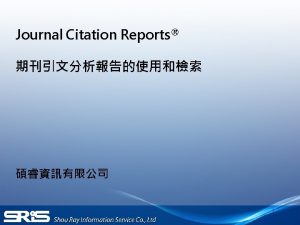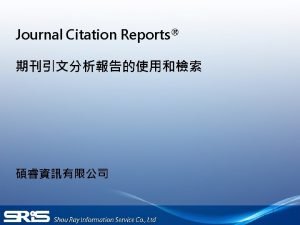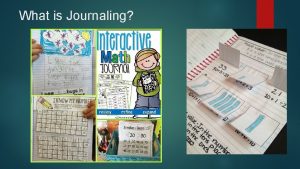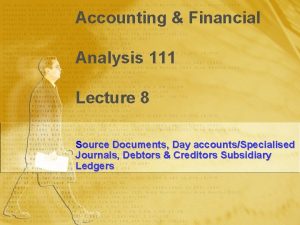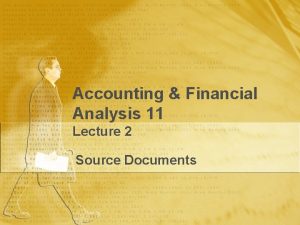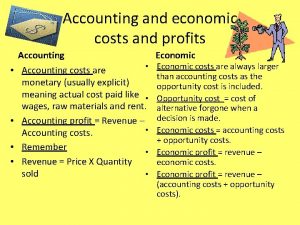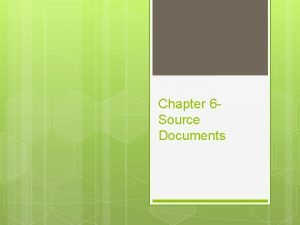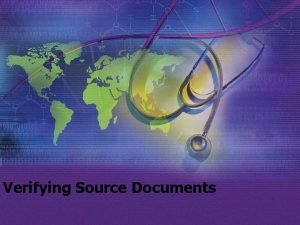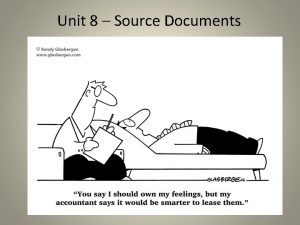The Journal and Source Documents 1 Accounting 1




























- Slides: 28

The Journal and Source Documents 1 Accounting 1, 7 th edition 6

Section Number 2 Title 6. 1 The Journal 6. 2 Source Documents 6. 3 Sales Taxes 6. 4 Building a Spreadsheet Model for Sales Tax Decisions Accounting 1, 7 th edition

3 Section 6. 1 Making Journal Entries 1. A Transaction (w/ Source Document) Occurs 2. The Transaction is Recorded in a Journal (Source Documents are filed away) 3. Accounting Entries are Transferred to the Ledger (TAccounts, Equation Analysis Sheet) 4. Conduct a Trial Balance 5. Prepare a Balance Sheet (Statement of Financial Position) and an Income Statement Chapt Accounting 1, 7 th edition er 6 –

4 Section 6. 1 Making Journal Entries A Journal (Book of Original Entry) provides a singular record that contains ALL Business Transactions. A Journal records all transactions in chronological order for reference purposes (preventing & checking for mistakes) Without a Journal, an Accountant’s Life is Hell Chapt Accounting 1, 7 th edition er 6 –

5 Section 6. 1 Making Journal Entries All Accounting entries are first recorded in the Journal Chapt Accounting 1, 7 th edition er 6 –

6 Making Journal Entries Debits Date Indent Then Credits Space Chapt Accounting 1, 7 th edition er 6 – Description PG. # Transactions Debits = Credits

7 Section 6. 1 Making Journal Entries All Accounting entries are first recorded in the Journal Even the Opening Entry (Taken from the Balance Sheet) Chapt Accounting 1, 7 th edition er 6 –

Section 6. 2 Source Documents All business transactions occur outside of the accounting department (by owners, managers, supervisors, sales people or purchasers, etc. ) Source Documents are Designed to: 1. Be objective (evidence provided by a 2 nd or 3 rd party) 2. Show the nature of a transaction and contain all of the necessary information to account for it in the books. 8 Accounting 1, 7 th edition

Section 6. 2 Source Documents Therefore All Accounting starts w/ Source Documents An Accountant must know: • The types of documents encounter in their industry • The features of these documents An Accountant must keep all documents for reference: • To track errors and test the books • To prove accuracy & honesty (Auditing/Taxes) 9 Accounting 1, 7 th edition

Section 6. 2 Source Documents (TYPES) • • • Invoices Sales & Purchase Orders Receipts (Cash & Credit Card) Cash Register Tapes (POS – Daily Summary) Cheques (VOID, Cancelled, Post-Dated, Certified) Check Stubs, Pay Slips, Time Cards Financial Statements (Bank, Credit Card, Loan) Bank Statements (Advices: Debit & Credit, Deposit & Withdrawal Slips) Vouchers (Coupons) Promissory Notes, Memos Delivery/Order Notes & Tickets/Fees/Fines 10 Accounting 1, 7 th edition

Section 6. 2 Source Documents Figure 6. 4: Cash Sales Slip 11 Accounting 1, 7 th edition

Section 6. 2 Source Documents Figure 6. 5: Sales Invoice Vendor (sales/seller) Purchaser (buyer) 12 Accounting 1, 7 th edition

Section 6. 2 Source Documents Figure 6. 6: Point of Sale Summary 2 Types: Reconciliation Transaction Log 13 Accounting 1, 7 th edition

Section 6. 2 Source Documents Figure 6. 7: Purchase Invoice 14 Accounting 1, 7 th edition

Section 6. 2 Source Documents Figure 6. 8: Purchase Invoice 15 Accounting 1, 7 th edition

Section 6. 2 Source Documents Figure 6. 9: Cheque 16 Accounting 1, 7 th edition

Section 6. 2 Source Documents Figure 6. 10: Cash Receipts Daily Summary Remittance (Payment Made) 17 Accounting 1, 7 th edition

Section 6. 2 Source Documents Figure 6. 11: Bank Debit Advice Memo 18 Accounting 1, 7 th edition

Section 6. 3 Taxes Vary (Between Products and even Provinces) Basic Taxes • PST – Provincial Sales Tax – 7% • GST – Goods & Services Tax – 5% Hidden Taxes • Cigarette Tax— 24. 7% • Cigars – 90% • Alcohol Tax (80% spirits, 70% wine and 50% beer + 15% at the Till) • Gasoline – 41% • Luxury – Starts @ 10% 19 Accounting 1, 7 th edition

Section 6. 3 Taxes LOOP HOLE – The Black Market (CASH ONLY) Most people think of the Black Market as a place that sells illegal goods and services The Black Market also includes any business that evades paying taxes Only Business that make over $30 000 a year are required to apply for certain business licenses, pay provincial taxes and complete a GST/HST registration form 20 Accounting 1, 7 th edition

Section 6. 3 Sales Taxes The Economics of Business (Buying & Selling) Taxes – Provides social benefits created by an individual’s needs and wants. The more a person consumes, the larger the contribution that person makes to improve society Taxation is complex – There are many rules & regulations (What to Tax? and How Much? ) 21 Accounting 1, 7 th edition

Section 6. 3 Sales Taxes (PST – Provincial Sales Tax) 4 Basic Taxation Principles 1. Tax dollars are charged to the buyer 2. Tax dollars are collected by the seller and recorded in a separate liability account 3. The tax dollars are owed to the government 4. The government requests its tax dollars at specific times of the year 5. Example 22 Accounting 1, 7 th edition

Section 6. 3 Value Added Taxes (GST - Federal Government) Sales Taxes (PST) are charged only on the final (Retail) sale of a (Good) product VS. Value Added Taxes are charged at every stage of a Good or Service’s production (Manufacturing) 23 Accounting 1, 7 th edition

Section 6. 3 Value Added Taxes (GST - Federal Government) A Value Added Tax means the government will only receive tax dollars on the value added to the product or service sold by the manufacturer à A (manufacturer) company will deduct any taxes it paid on purchasing supplies from the amount of tax money the company owes the government due to sales à A (manufacturer) company is refunded any tax it pays 24 Accounting 1, 7 th edition

Section 6. 3 Value Added Taxes (GST - Federal Government) The Payable Account refers to taxes collected on the Goods Sold by the company The Recoverable Account refers to the taxes spent on buying supplies (to create the Goods) The company only pays the government the difference between the two accounts (Closes the other accounts CR 1050 + CR 350 = DR 1400) 25 Accounting 1, 7 th edition

Section 6. 4 Spreadsheet Model: Sales Tax Decisions Open the Chapter 6 Rendal. xls spreadsheet 26 Accounting 1, 7 th edition

Section 6. 4 Spreadsheet Model: Sales Tax Decisions New Functionalities • Autofill – Drag down the bottom right corner of an active cell, it will fill the lower cells with values based on the currents Cell Reference • Cell Referencing – C 13 will be variable and change when copied to new locations (Shortcut: Use Mouse Pointer) • Absolute Cell Referencing --$C$13 will not change in value when copied to a new location (Shortcut: press F 4 to change a cell reference to an absolute cell reference) 27 Accounting 1, 7 th edition

Section 6. 4 Spreadsheet Model: Sales Tax Decisions New Functionalities • Auto. Sum – A function that adds all the contents specified in the blue box. Click the Auto. Sum function (under the Formula Tab) and manipulate the box so that it fills the desired cells • • • Formatting – See Below: The Paint Bucket is on the home page To access Alignment, Borders and Underlining right-clickand select Format Cells 28 Accounting 1, 7 th edition
 Purchase book format
Purchase book format Slide todoc.com
Slide todoc.com Source documents
Source documents Source documents
Source documents Branch balance sheet
Branch balance sheet State the formula for proving cash
State the formula for proving cash Introduction to forensic accounting
Introduction to forensic accounting Abnormal spoilage journal entry
Abnormal spoilage journal entry Types of hire purchase ppt
Types of hire purchase ppt Equity method accounting journal entries
Equity method accounting journal entries Payroll liabilities journal entry
Payroll liabilities journal entry Appretaite
Appretaite Financial accounting and accounting standards chapter 1
Financial accounting and accounting standards chapter 1 Disadvantages of documents and records
Disadvantages of documents and records Hát kết hợp bộ gõ cơ thể
Hát kết hợp bộ gõ cơ thể Slidetodoc
Slidetodoc Bổ thể
Bổ thể Tỉ lệ cơ thể trẻ em
Tỉ lệ cơ thể trẻ em Chó sói
Chó sói Tư thế worm breton là gì
Tư thế worm breton là gì Chúa sống lại
Chúa sống lại Các môn thể thao bắt đầu bằng từ đua
Các môn thể thao bắt đầu bằng từ đua Thế nào là hệ số cao nhất
Thế nào là hệ số cao nhất Các châu lục và đại dương trên thế giới
Các châu lục và đại dương trên thế giới Công thức tiính động năng
Công thức tiính động năng Trời xanh đây là của chúng ta thể thơ
Trời xanh đây là của chúng ta thể thơ Mật thư tọa độ 5x5
Mật thư tọa độ 5x5 101012 bằng
101012 bằng độ dài liên kết
độ dài liên kết


